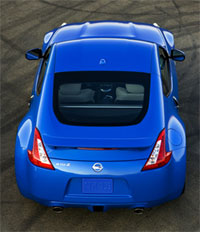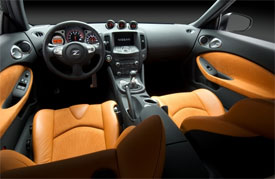2009 Nissan 370Z
When Nissan’s first Z-car arrived for 1970 as the Datsun 240Z, no one predicted the enormous acclaim this affordable sports car would enjoy. But over time and redesigns, Nissan lost its focus and the Z grew expensive and fat. That’s why when the reworked 2003 Nissan 350Z drove back to basics, everyone applauded. Well now, for 2009 it’s time for a Z update again. So, let’s see if the crowd will still roar.
Avoiding the mistakes that ultimately doomed the first Z-car series, Nissan approached this iconic re-design with an eye toward maintaining balance, carefully adding technology to enhance performance and comfort while also trimming weight and size to retain its nimble and sporty nature.
Styling updates are somewhat subtle. At first glance, the overall shape is similar, with familiar proportions to the wide stubby nose and canopy-style cockpit. But the rear hatch angle is less steep now, and character lines like the upswept rear quarter windows and artful head- and tail-lamps add sizzle to what was becoming a bland design. It’s racy, with a few bits borrowed from the big brother GT-R’s insolent aggression.
At 100.4, almost 4 inches has been chopped from the 370Z’s wheelbase. That was done by moving the rear wheels forward. The car is also shorter, slightly wider, and lower with a corresponding lower center of gravity.
Weight savings come from using aluminum for the doors, hood and hatch, as well as carbon-fiber for key structural braces and the shorter driveshaft. New technology and safety features add back a few pounds, but the net result is 95 pounds under the previous Z.
 Motivation comes from Nissan’s corporate dual-overhead-cam, 24-valve V6, now displacing 3.7 liters, hence the name change. The engine is also used in the Infiniti G37. Horsepower is up 26, now standing at 332. Torque bumps up a couple pound-feet, to 270. Transmitting power to the pavement is a new 7-speed paddle shifter automatic or our tester’s 6-speed manual gear box with the world’s first synchronized downshift rev-matching feature. This gizmo recognizes when a lower gear is selected and blips the throttle for smoother clutch engagement; much like heel-and-toeing, but without the fancy footwork. For the purists, it can be turned off. UP-shifting with the closely spaced gearbox results in 0 to 60 times of 5.1 seconds. The full quarter-mile flashes by in 13.7 seconds at 105 miles-per-hour.
Motivation comes from Nissan’s corporate dual-overhead-cam, 24-valve V6, now displacing 3.7 liters, hence the name change. The engine is also used in the Infiniti G37. Horsepower is up 26, now standing at 332. Torque bumps up a couple pound-feet, to 270. Transmitting power to the pavement is a new 7-speed paddle shifter automatic or our tester’s 6-speed manual gear box with the world’s first synchronized downshift rev-matching feature. This gizmo recognizes when a lower gear is selected and blips the throttle for smoother clutch engagement; much like heel-and-toeing, but without the fancy footwork. For the purists, it can be turned off. UP-shifting with the closely spaced gearbox results in 0 to 60 times of 5.1 seconds. The full quarter-mile flashes by in 13.7 seconds at 105 miles-per-hour.
Power delivery is smooth all the way to the 7500-RPM redline, and a noticeably deeper growl resonates from the Z’s dual exhausts. We pushed the Z through sustained high-speed lapping around Savannah, Georgia’s Roebling Road Raceway, where Nissan’s new balancing act really paid off.
A new double-wishbone front suspension and stiffer 4-link rear setup combine with new “high-response” shocks at each corner to reduce impact harshness and improve grip.
The tighter body structure, smaller footprint and refined suspension all combine for handling that is easily on par with much pricier machines. The overall attitude is neutral with sharp turn-ins, responsive steering and just enough power-on over steer to keep things entertaining but still under control.
The 370Z squirts from corner to corner with a fluid grace, connecting the driver with the road in a way all but forgotten by today’s hyper-fast, do-it-all-for-you supercars, including the GT-R. And it brakes fast too: a short 119 feet on average from 60 to 0 with a nice firm pedal.
Perhaps more impressive is how the Z handles routine driving. Three days on the track and then fifteen hours straight on the Interstate and zero complaints. Especially with Government Fuel Economy ratings of 18 city/26 highway and a cruising range of more than 450 miles. The driver sits in a still cozy cockpit with better-quality materials and more upscale details in the stitching and trim. And, yes, there is finally a proper glove box.
The standard cloth bucket seats have anti-slip inserts, but our touring model upgrades with leather trim plus seat power and heat. Lateral support is good without being too firm.
 Tach and speedo needles spin in a brushed-look hooded pod which still moves with the tilt wheel. Ancillary gauges reside in a signature triple cluster atop the center dash, stacked, in our car, above touch-screen navigation, a Bose CD stereo with XM, and rotary knobs for the climate controls.
Tach and speedo needles spin in a brushed-look hooded pod which still moves with the tilt wheel. Ancillary gauges reside in a signature triple cluster atop the center dash, stacked, in our car, above touch-screen navigation, a Bose CD stereo with XM, and rotary knobs for the climate controls.
The intrusive strut brace that once divided and diminished the cargo area has been moved forward and incorporated behind the seats, along with a small parcel shelf and a pair of bins. Pricing for the 2009 370Z starts at a budget-friendly $29,930 for the manual trans base car and climbs to a still-reasonable $35,760 for a Touring Edition automatic.
It speaks volumes that the Z was our favorite track car in a pit lane shared with stars from Audi, BMW and Porsche. The Nissan 370Z is much more than just retro-cool. It rockets back to what sport cars were meant to be: Eye catching and nothing but fun to drive. It is, in a word , amazing!
Specifications
- Engine: Dual-overhead-cam, 24-valve V6
- Horsepower: 332
- Torque: 270 Lb Feet
- 0-60 MPH: 5.1 Seconds
- 1/4 Mile: 13.7 Seconds @ 105 MPH
- 60-0 MPH: 119 Feet
- EPA: 18 MPG City/ 26 MPG Highway






